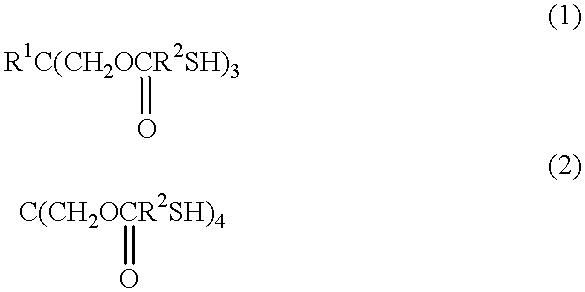Curable resin composition
a technology of resin composition and resin resin, applied in the field of curable resin composition, can solve the problems of organic glass not being suitable as a lens material for eye glasses, affecting the appearance, and affecting the appearance,
- Summary
- Abstract
- Description
- Claims
- Application Information
AI Technical Summary
Benefits of technology
Problems solved by technology
Method used
Image
Examples
example 1
A mixture of 2.5 parts of diallyl isophthalate, 10.0 parts of triallyl isocyanurate, 45.9 parts of divinylbenzene, 41.6 parts of pentaerythritol tetrakisthioglycolate, and 1.5 parts of 1, 1'-azobis(1-acetoxy-1-phenylethane) was cast in a mold having two glass plates, put in a thermostat bath and gradually heated from 40.degree. C. to 120.degree. C. for 20 hours. After being demolded from the mold, the resultant curable resin was heated further at 120.degree. C. for 1 hour to carry out the post-polymerization.
The resultant cured resin was colorless and transparent and had a refractive index of 1.60, an Abbe number of 35, and a thermal distortion temperature of 63.degree. C.
examples 2 to 4
The mixtures having the ingredients shown in Table 1 were subjected to the cast polymerization in the same manner as in Example 1 and the physical properties of the cured resins were measured. The results were shown in Table 2.
PUM
| Property | Measurement | Unit |
|---|---|---|
| refractive index | aaaaa | aaaaa |
| viscosity | aaaaa | aaaaa |
| viscosity | aaaaa | aaaaa |
Abstract
Description
Claims
Application Information
 Login to View More
Login to View More - R&D
- Intellectual Property
- Life Sciences
- Materials
- Tech Scout
- Unparalleled Data Quality
- Higher Quality Content
- 60% Fewer Hallucinations
Browse by: Latest US Patents, China's latest patents, Technical Efficacy Thesaurus, Application Domain, Technology Topic, Popular Technical Reports.
© 2025 PatSnap. All rights reserved.Legal|Privacy policy|Modern Slavery Act Transparency Statement|Sitemap|About US| Contact US: help@patsnap.com



